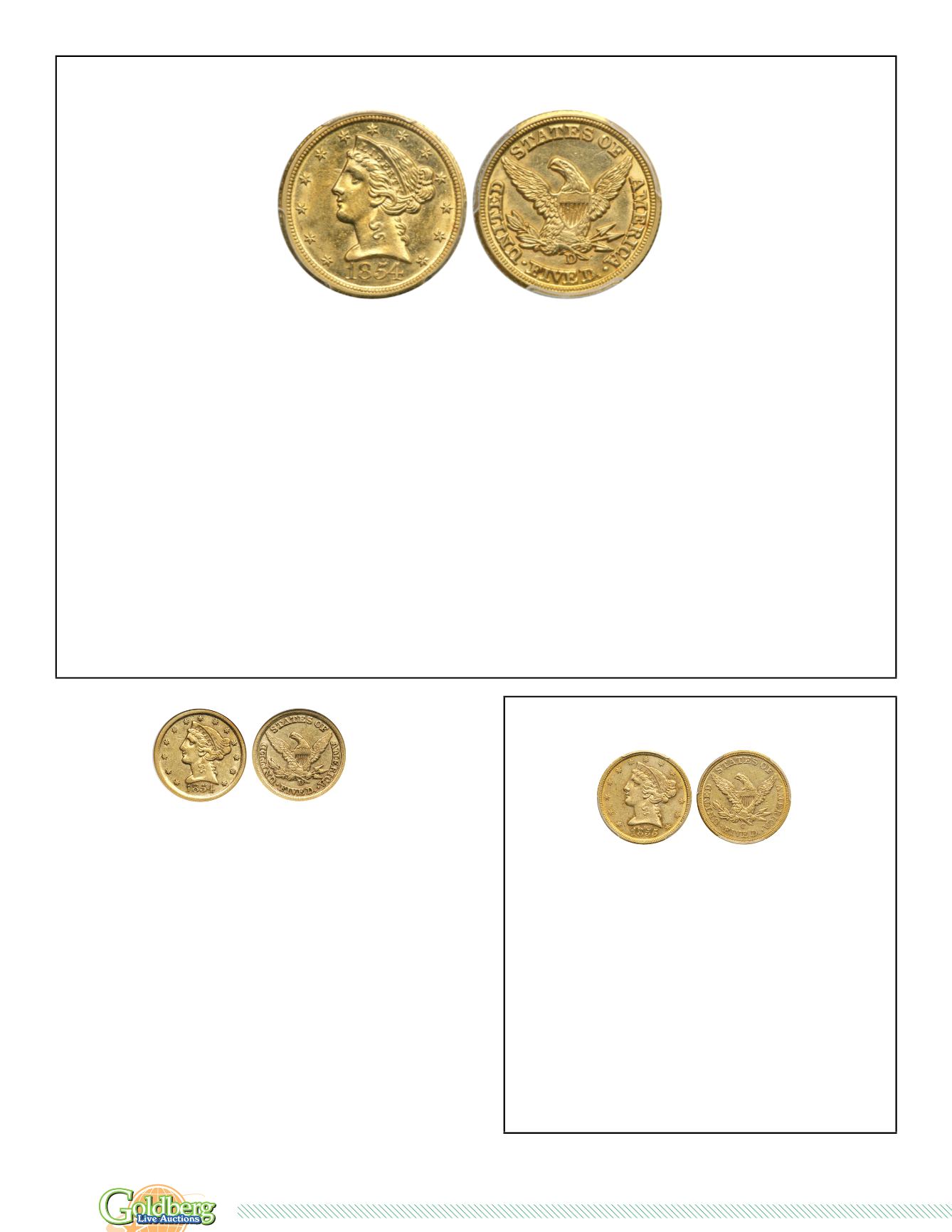
276
|
$5 Gold
R
ARE
M
INT
S
TATE
1854-D $5 L
IBERTY
Enlargement
1818
1854-D. Large D
.
PCGS graded MS-62
. Mostly untoned. Only 56,413 minted. A satiny coin with energetic luster beaming across the sur-
face on both sides, this includes light golden color that seems to want to motivate bidders to increase their bids as though by subtle hypnosis!
Clear-cut devices point to the coin having been giving a full strike by the dies. Rims free of bruising and all dentils show nicely. We’d like to
repeat and emphasize that the mint luster rolls around both sides with a pleasing sheen. A thoroughly delightful coin, a thoroughly marvelous
opportunity!
Pop 8; 6 finer, 3 in 63, 1 in 64, 1 in 64+, 1 in 65
. (
PCGS # 8258
)
Anyone with a general interest in American gold coins will enjoy the opportunity to make a serious beginning in the popular Charlotte Mint
and Dahlonega Mint series, as well as acquire examples of just about any other desired date and mintmark within the Half Eagle denomina-
tion. In the coming years numismatists will be very proud of the pieces that bear Dahlonega’s famous and historic “D” mintmark. The color of
the Dahlonega gold coins was more a function of the minting methodology employed at the facility, than of the raw material from which they
were produced. In fact, the Dahlonega Mint produced gold coins from a variety of gold sources: naturally-occurring gold (from Georgia, as
well as other states), foreign gold coins, gold bullion, scrap gold, etc. The Dahlonega Mint even produced coins from gold that was brought in
from great distances. For example, the Dahlonega Mint actually coined a great deal of California gold from 1851-1854, which was brought
back by local miners returning from the California gold fields. Thus, there is no foolproof way to know whether or not a particular Dahlonega
gold coin was produced from locally mined metal.
The evidence shows that the gold coins produced at Dahlonega had a "high" silver concentration (when compared with gold coins produced
at the parent mint in Philadelphia). Although some other regions (such as California) generally had lower purity gold, the lower purity gold
had to be refined prior to minting, thus removing most (or perhaps virtually all) of the silver. The resulting gold would then be alloyed with
copper and perhaps a small amount of silver. Thus, the resulting gold coins had less silver than their Dahlonega cousins. Also, the "green
gold" characterization of some Dahlonega gold is a visual interpretation of color differences among coins and is therefore very subjective.
Estimated Value ........................................................................................................................................................... $11,000 - 12,000
1819
1854-D. Large D
.
NGC graded EF-45
. A bold strike. We note
a scratch in the left obverse field in front of Liberty's eye. The
central motifs are well displayed, with most of Liberty's detail
and the eagle and shield showing plainly. No obverse rim denti-
cles, possibly due to a worn did since this portion of a coin die
experiences major stress and wear during coining. Only 56,413
minted. (
PCGS # 8258
)
Estimated Value ..............................................$1,500 - 1,600
S
CARCE
1855-C $5 L
IBERTY
1820
1855-C
.
PCGS graded AU-58
. Nice golden toning. Only
39,788 minted. A small mark by star 2 can be used to iden-
tify this coin. There is much to say about the beautiful color
and originality of this frosty coin since they are clearly
higher quality than the usual Very Fine to Extremely Fine
specimen from this branch mint. A quality most difficult to
obtain. The mint frost is aglow around and throughout the
main devices on either side. There is just a bit of light yel-
low-gold patina as well. This is an otherwise strongly struck
example, including nice detail to all the important high
points, with the possible exception of these regions (stan-
dard for the issue): the eagle’s claws, some neck feathers,
and minor rounding on the arrowheads and shield outline.
Large C mintmark occupies the center area between the
denomination and the branch end.
Pop 5; 3 finer, 1 in
60, 1 in 62, 1 in 63
. (
PCGS # 8262
)
Estimated Value ........................................ $5,000 - 5,500


